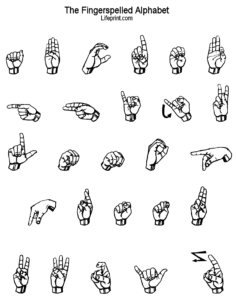Overview:
American Sign Language is one of over 135 confirmed sign languages around the world, and the most commonly practiced in the United States as well as Canada. Considered to be an “official” or “complete” language, American Sign Language, commonly referred to as ASL, uses movements of the hands, face, and postures in order to convey linguistic information to an observer’s brain³. In many deafened children, ASL is a critical aspect in developing language abilities. While some view sign languages as primitive or simple, ASL incorporates complex rules for guiding signs – a grammar comparable in intricacy but not in similarity to that of English. Additionally, facial expressions are a large aspect to ASL and convey more valuable information alongside the signs themselves. In order to accurately understand American Sign Language, signers must take into account five parameters guiding meaning:
- Handshape
- The configuration of a signer’s hand(s). Handshape is fundamental in distinguishing signs², and is usually the first and most simple feature of ASL to be learned.
- Example: the alphabet! Each letter corresponds to a unique handshape.
- Handshapes can be easily confused to the untrained eye, so identification is critical to the effective learning and use of ASL.
- Palm Orientation
- Palm orientation refers to the direction in which a hand or hands is/are facing when producing a certain sign.
- Possible directions may include facing left, right, inwards, outwards, up, or down.
- Just like handshape, a difference in palm orientation can alter the meaning of a sign
- Location
- The location parameter involves the area of the body in which a sign is produced (around the head and face, chest level, waist level, and more).
- Again, this parameter can guide you to the correct meaning if handshape or orientation of the sign provides an ambiguous reference.
- For example, a sign at the forehead typically refers a female in some manner (wife, sister, mom), whereas a sign at the chin typically refers to a male (husband, brother, dad).
- Movement
- The manner in which a sign changes via handshape, orientation, or location. The directionality or way in which a sign moves may signify or correspond to a certain meaning.
- For example, moving a sign away from yourself and towards the observer adds an essence of “you,” or directing a message to the observer.
- Non-Manual Markers
- Non-manual markers refer to the gestures, symbols, or movements performed without the hands that add further meaning to a sign.
- These involve, most notably, facial expressions. ASL signers are sometimes viewed as being uncharacteristically overenthusiastic in their signs – this is because facial expressions plays a large role in determining meaning. An over-pronounced expression can add a sense of “more” or “very” to a sign, such as “very tired” rather than just “tired.”
- A very difficult adjustment (for English speakers) in learning ASL is the use of the eyebrows. Furrowing your brows indicates a WH question – who, what, when, where, why (and how?). Raising the brows signifies a yes or no question.
- Head nods can convey meaning as well. Shaking your head no while signing can add a negative. For example, signing “understand” while shaking your head means “I don’t understand.”

Pros and Cons of ASL:
Pros:
- Ease in communicating with DeafBlind, Deaf, and Mute persons.
- ASL is the most widespread sign language in North America.
- ASL can be used even in the noisiest or most silent of situations. It can be understood by other fluent signers regardless of environment, but it also does not cause disruptions.
- American Sign Language is a large part of the experience in the Deaf community. Many Deaf people embrace their conditions, and some outright object to the use of hearing technology such as hearing aids or cochlear implants. Among all members of the community, however, ASL is a staple for communication and connects the Deaf.
- Sign language assists in developing motor skills¹ in children, whether Deaf or hearing.
- ASL can accompany spoken language for ease of access for hearing and Deaf people alike, which is why some parents encourage the use of “baby signs.”
- ASL is often used in the bilingual-bicultural approach, in which ASL is used for learning and communicating but English is used for reading and writing. This optimizes language skills.
Cons:
- If ASL is one’s first or primary language, fluency in all educators, family, and friends is optimal for the signer’s language skills.
- Not all are physically able to use ASL. Those experiencing motor difficulties¹ are limited in movements.
- ASL can only be used as far as one can see the details of signs and facial expressions. This is usually within close proximity. If someone is facing away from you, there is no way to gain their attention outside of making a sound or touching them.
- Difficulty in communicating with several people at once or in group environments.
- Multitasking is hard. You can’t take notes, eat, type or do anything other activities that involve the use of hands while signing.
- Deaf children with a first language of ASL can sometimes experience delays in learning English and, as a result, significant setbacks in reading and writing.
- ASL is NOT equivalent to English. ASL cannot be translated, only interpreted, and some English words do not directly convey to signs and vice versa.
American Sign Language in Language Acquisition:
There are many advantages to learning ASL, for deaf and hearing children alike. However, early use of this sign language is critical for deaf children that are not exposed to any other kind of language as it becomes their primary means for communication.
Development of language is critical to the social and cognitive wellbeing of preschoolers, and this exposure must occur at a young age for optimal proficiency⁴ in receptive and expressive language. For deaf children lacking English or another spoken language, this must be done through sign language.
Many developmental and child psychologists agree that the use of sign language can help limit the gap between Deaf and hearing toddlers. While typically developing children experience language milestones such as babbling, one word utterances, and more up until complex language abilities, these developments are mirrored in preschoolers who were exposed to sign language from infancy as well. While a deafened infant may not babble vocally, they are capable of manual babbling which consists of movement repetitions. At the preschool age, deaf children who communicate primarily in ASL reach four to six word utterances, while hearing children do the same in spoken language. By the age of 5, fluent and more complex statements can be made, even in sign. Notably, these effects are only apparent in Deaf children exposed to ASL from a young age, which is why sign language is a popular method used by parents and educators in propelling language acquisition and must be continued at the preschool age.
Overall ASL is known to improve the following in Deaf and Hard of Hearing preschoolers:
- size of vocabulary⁵
- grammar
- comprehension of language
- ability to express thoughts
- social connections
- bridging the gap in language delays
ASL in Education:
In order to incorporate ASL into a child’s education, they must be afforded a Deaf-friendly classroom⁶, with access to an interpreter, simple communication rules to regulate turn-taking, appropriate seating arrangements, visual lesson components, captioning when necessary, and trained professionals. Because preschool is the first step into the education system, providing the resources needed for deaf children to succeed at this stage is critical for their development.
While most deaf children fluent in ASL reach proficient levels of English, lack of support in this area can lead to deficits in reading and writing. Since ASL and English are not interchangeable and preschool education usually provides the first steps towards reading and writing, kids at this age require guidance and close attention in order to achieve literacy and a comprehensive understanding of language.
The continuation of American Sign Language throughout preschool with assist in flourishing children’s language as it becomes more complex in adjusting to the environment and communication demands.
ASL Friendly Sample Activity: “Draw Me A..”
Materials required: Paper and drawing utensils
A teacher/parent/specialist signs instructions such as “Draw me a house with three windows” or “Draw me a horse and a cat,” which the student must then draw on their paper. This can become increasingly difficult, to the point of “Draw me a mother and a daughter kicking a soccer ball in the park” depending on the abilities of the children. This tests receptive skills and can be used to introduce new vocabulary signs into the classroom. If writing is a current goal, the task can be adjusted to involve writing down the simple sentences to improve ability in overall comprehension and expression between ASL and English.
Activity adapted from: Webster, A., & Ellwood, J. (1985). The hearing-impaired child in the ordinary school. Croom Helm,: London.

Notes:
1 – Motor development; Motor development is the change in motor behavior over the lifespan and the processes that underlie that change. It represents the body and brain working in sync, and researchers agree that motor development beings with simple reflexes and progresses to more sophisticated movements over time. The fundamental period (ages 1-7) which encompasses the preschool age involves the development of fine and gross motor skills, or regulation of the small muscles and large muscles. In using sign language, children must possess the fine motor skills to form the handshapes and finger/hand movements required to convey meaning. As they grow older and refine these skills, they are able to create more complex signs.
2 – Signs and symbols as a milestone in development; Signs, the use of objects, words, or actions with no resemblance to a target as its representative; Symbols, the use of objects, words, or actions to represent something analogous in the environment. Signs and symbols are a key aspect of the preoperational stage in Piaget’s theory of cognitive development. They allow for symbolic thinking in order to represent items through mental processes. Because some “signs” in sign language mirror their physical referent and some do not, sign language can incorporate both signs and symbols, aiding children in cognitive advancements.
3 – The Wernicke’s area of the brain, part of the left temporal lobe, is involved with the ability to receive and process linguistic information. The use of this area, even in signed languages, is critical for comprehension.
4 – Critical Period Hypothesis; the Critical Period Hypothesis suggests that the first few years of life (before puberty) represent the optimal time period in which a skill is to be obtained for optimal proficiency. This is due to plasticity/cortical reorganization, or the way in which the brain adapts or adjusts in response to experiences. In the context of language, this means that the few years following birth (some suggest birth-age 7) must involve exposure to some sort of language in order to progress in language development in an age-appropriate manner. The lack of exposure to language during this period is detrimental, and one may never recover from the delays.
5 – Vocabulary; Vocabulary is the corpus of words that hold meaning for an individual and represents their prior knowledge. It is thought to be indicative of future language achievements in that larger vocabularies imply exposure to more rich content of language. The use of sign languages aids in promoting vocabulary expansion because it helps children to learn to refer to objects in their physical environment. Even hearing children who use baby signs demonstrate improved vocabulary. This will play a large role in future success in reading and writing.
6 – Classroom environment; the social atmosphere of a classroom, the way in which it provides resources to students, and the teacher-student involvement. Situated cognitivists recognize the role of proper classroom environments in promoting meaningful engagement. This includes both human and nonhuman resources. In a Deaf friendly classroom, it is critical that the student is afforded the means to communicate in their sign language, but also learn effectively through class materials that aren’t dependent on sound.
